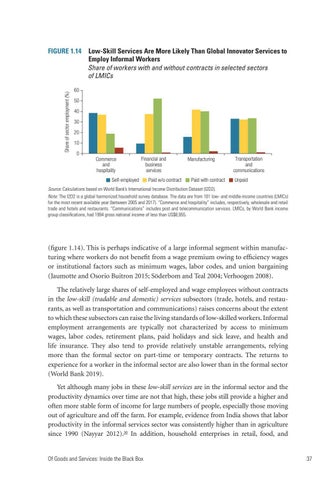Share of sector employment (%)
FIGURE 1.14 Low-Skill Services Are More Likely Than Global Innovator Services to Employ Informal Workers Share of workers with and without contracts in selected sectors of LMICs 60 50 40 30 20 10 0
Commerce and hospitality
Financial and business services
Self-employed
Paid w/o contract
Manufacturing
Paid with contract
Transportation and communications Unpaid
Source: Calculations based on World Bank’s International Income Distribution Dataset (I2D2). Note: The I2D2 is a global harmonized household survey database. The data are from 101 low- and middle-income countries (LMICs) for the most recent available year (between 2005 and 2017). “Commerce and hospitality” includes, respectively, wholesale and retail trade and hotels and restaurants. “Communications” includes post and telecommunication services. LMICs, by World Bank income group classifications, had 1994 gross national income of less than US$8,955.
(figure 1.14). This is perhaps indicative of a large informal segment within manufacturing where workers do not benefit from a wage premium owing to efficiency wages or institutional factors such as minimum wages, labor codes, and union bargaining (Jaumotte and Osorio Buitron 2015; Söderbom and Teal 2004; Verhoogen 2008). The relatively large shares of self-employed and wage employees without contracts in the low-skill (tradable and domestic) services subsectors (trade, hotels, and restaurants, as well as transportation and communications) raises concerns about the extent to which these subsectors can raise the living standards of low-skilled workers. Informal employment arrangements are typically not characterized by access to minimum wages, labor codes, retirement plans, paid holidays and sick leave, and health and life insurance. They also tend to provide relatively unstable arrangements, relying more than the formal sector on part-time or temporary contracts. The returns to experience for a worker in the informal sector are also lower than in the formal sector (World Bank 2019). Yet although many jobs in these low-skill services are in the informal sector and the productivity dynamics over time are not that high, these jobs still provide a higher and often more stable form of income for large numbers of people, especially those moving out of agriculture and off the farm. For example, evidence from India shows that labor productivity in the informal services sector was consistently higher than in agriculture since 1990 (Nayyar 2012).30 In addition, household enterprises in retail, food, and Of Goods and Services: Inside the Black Box
37

